Before Shaw’s Tavern there was Ethical Pharmacy
This is the fourth in a series of the Scurlock photos. Read the others.
We have reported before on the coming of Shaw’s Tavern to the building (pictured above) at the southeast corner of 6th Street and Florida Avenue. It turns out that the bar at Shaw’s Tavern will not the be the first establishment to stir up elixirs at that location.
While perusing the Smithsonian’s Scurlock photo archives, we found that one of the building’s previous tenants was the Ethical Drug Store (also known as Ethical Prescription Pharmacy and Ethical Pharmacy), one of the many black-owned businesses along the 400 – 600 blocks of Florida Avenue NW.
Pharmacist Lewis Terry (1904- 1978) graduated from pharmacy school at Temple University in 1928. The following year he opened Ethical Pharmacy at 518 Florida Avenue NW. The pharmacy had filled 1 million prescriptions by 1953 earning him a special honor from Temple. Though Mr. Terry sold the business in the mid-60s, the pharmacy stayed in operation until the 1990s.
The name Ethical Pharmacy is a relic of a professional division in the pharmacy field a century ago. An “ethical pharmacy” proudly devoted itself solely to filling prescriptions and did not sell other extraneous products as modern drug stores, such as CVS, do today. The use of ‘ethical’ was a high-minded misnomer since a pharmacist could sell other wares ethically or devote himself exclusively to quack medicine.
The Scurlock Studio photographed the pharmacy in 1937 and again in 1950. We have included both photo shoots below.
1937
Here is a photo Addison Scurlock took of Ethical Pharmacy in 1937:
Here are some other shots of the interior. Though the Smithsonian has no date for the first two, we suspect they was shot in the 1930s. The third photo is dated 1937 and judging from the change in the interior, we suspect the pharmacy had undergone some sort of renovation to appear more modern.
1950
Mr. Scurlock photographed the pharmacy again in July 1950:
He also took more shots of the interior in 1950:
1968 riots at 7th & T Streets NW
This is the third in a series on the Scurlock photo archive. Read the others.
The 1968 riots burned and economically destroyed many commercial districts throughout Washington. Riots came to U Street, too, and several properties which were obliterated have not entirely recovered from the devastation.
After World War II, many of America’s cities faced population and economic decline as the nation suburbanized; Washington was certainly no exception. The retail corridors on 14th St NW, U St NW, and H St NE were already declining when riots hit American cities in 1968 following the Martin Luther King’s assassination.
Addison Scurlock (1883-1964) was Washington’s most prominent black photographer and when the riots started in April 1968, Mr. Scurlock[‘s sons, who inherited his studio] at 9th and U Streets (where Nellie’s now stands) knew that [they were]he was witnessing history in the making. Mr. Scurlock The Scurlocks photographed rioters at the beginning of the riots and photographed some of the aftermath.
The corner of 7th Street, Florida Avenue, and Georgia Avenue suffered from the mayhem. The southwest corner now houses a CVS and a parking lot on land that Howard University owns. Beneath this store runs the Metro tunnel between the Shaw and U Street stations. Back in 1968, this site featured a strip of retail stores until the riot.
One of the most striking Scurlock photos is of the northwest corner of 7th and T Streets NW, where the CVS currently stands. Rioters burned the buildings that stood on the site.
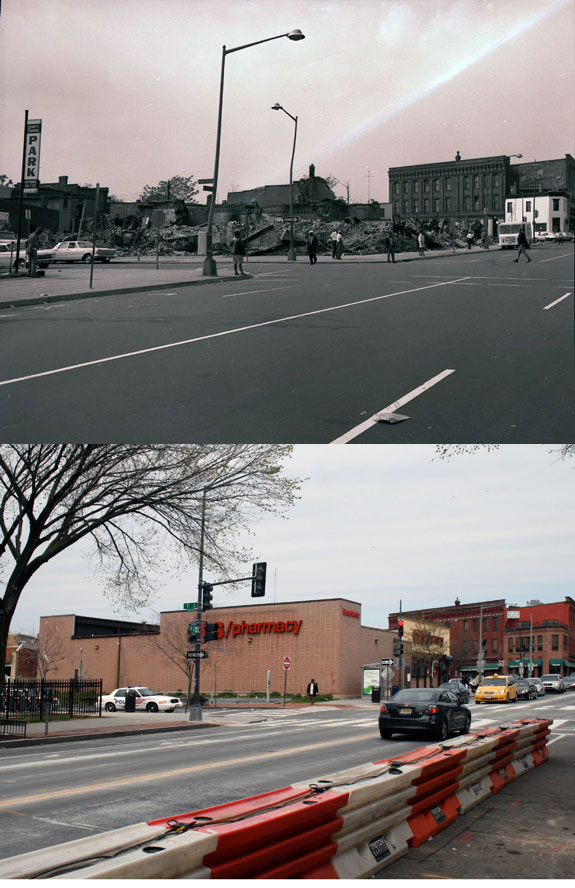
[Toggling between now and then photos will not work in RSS readers. View the actual post]
7th & T was always the seedier end of the U Street corridor
This is the second in a series on the Scurlock photo archive. Read the first entry.
During the Jazz Age of the 1920s and later into the 1930s, U Street was dubbed the “black Broadway” as it featured such venues as the Lincoln Colonnade (now the Lincoln Theater), the Howard Theatre, and other clubs and restaurants. In a segregated city in which blacks were excluded from most restaurants, theaters, and stores, U Street served as a refuge to catch a show and enjoy a meal.
This photo from the Scurlock archives was taken looking east at 7th and T Streets NW in 1939.
[Toggling between now and then photos will not work in RSS readers. View the actual post]
We have referred to this area as the block of blight for its dilapidated buildings, copious litter, and frequent police arrests. It turns out that some things never change. Even when this photograph was taken, U Street was not uniform in character and the area around the Howard Theatre was considered downscale compared to the classier venues west on U Street. (For more on U Street’s evolution, see Blair Ruble’s recent book, Washington’s U Street: A Biography.)
Pictured here at the corner is National Grill, which, like Harrison’s Café in LeDroit Park, advertised itself as open all night. The lighted vertical sign attached to the façade appears to read “LUNCH” and the pediment at the cornice bears the building’s name, “Scott’s”. (View a larger version of the photo.)
Just to the right (south) of National Grill is the S.W. Keys Luncheonette, whose vertical sign advertises coffee and waffles. Just south of that is Harlem Cafe, located in a building that has since been replaced.
On T Street, just behind Scott’s Building and just before the Howard Theatre, you will see a sign that reads “BILLIARDS”. That marks Frank Holliday’s pool hall, a popular gathering spot for Howard scholars, jazz musicians, and city laborers alike. Duke Ellington captured the scene at the pool hall:
Guys from all walks of life seemed to converge there: school kids over and under sixteen; college students and graduates, some starting out in law and medicine and science; and lots of Pullman porters and dining-car waiters.
Just beyond the pool hall, you’ll see the Howard Theatre sporting its original Italianate façade. The theater was later covered with plaster, which was only recently removed for the restoration project.
Today the last two buildings on 7th Street are a Chinese take-out and a tiny market. One of the developers of Progression Place, the large development project underway on the block (rendering below), said that the late owner of these two buildings refused to sell to his development. Progression Place will incorporate every building on this block except for these two.
If anyone is looking for a two-building restoration project, here is your chance!
Scurlock archives: Harrison’s Café
If you have ever walked by Nellie’s Sports Bar at 9th and U Streets NW, you may have noticed a small plaque on the wall noting the site of the former Scurlock Studio.
Addison Scurlock (1883-1964) was a prolific Washington photographer whose studio stood at that corner from 1911 to 1976. During his lifetime, Mr. Scurlock’s studio photographed mundane portraits and scenes, but also photographed famous people such as Frederick Douglass, Marian Anderson at the Lincoln Memorial and Martin Luther King and FDR at Howard University.
The Smithsonian purchased his collection and in paging through the online catalog, we found several photographs of scenes around LeDroit Park. This is the first in a series of photos.
[Toggling between now and then photos will not work in RSS readers. View the actual post]
This undated photograph shows Harrison’s Café, which stood at 455 Florida Avenue NW on the edge of LeDroit Park. It was a neighborhood restaurant and bar that attracted the various musical and academic notables of the area.
HARRISON’S CAFÉ
OPEN ALL NITE
SALADS SANDWICHES
Update: We took a trip to the Washingtoniana Division of the MLK Library and found more information on Harrison’s Café.
Robert Hilliard Harrison opened a candy store at 467 Florida Avenue NW and soon opened his cafe at 455 Florida Avenue NW in 1920. Harrison’s Café catered to a variety of appetites, serving fancy lobsters to 20-cent hamburgers. In an era of segregated restaurants, black residents have fewer dining choices and Harrison’s tried to serve them all.
Attached to the cafe, Mr. Harrison also owned the Golden Room, which hosted banquets and private events. Above the cafe, Harrison’s served liquor privately after the city’s midnight liquor curfew.
After World War II, LeDroit Park, like other close-in urban neighborhoods suffered from disinvestment and decline. Mr. Harrison died in 1957 and the restaurant closed in 1962.
Further reading:
- Fitzpatrick, Sandra. The Guide to Black Washington.
- Ruble, Blair A. Washington’s U Street: A Biography.

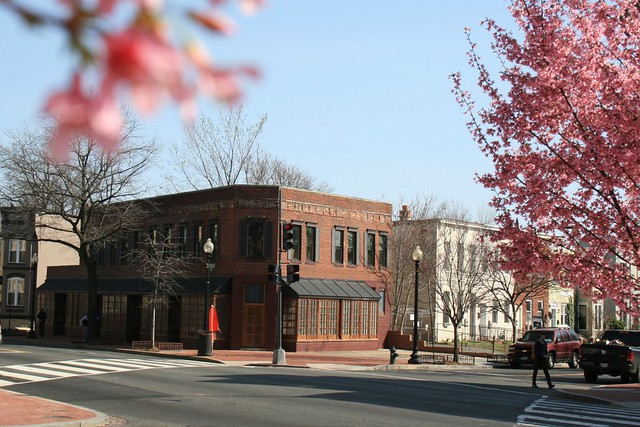
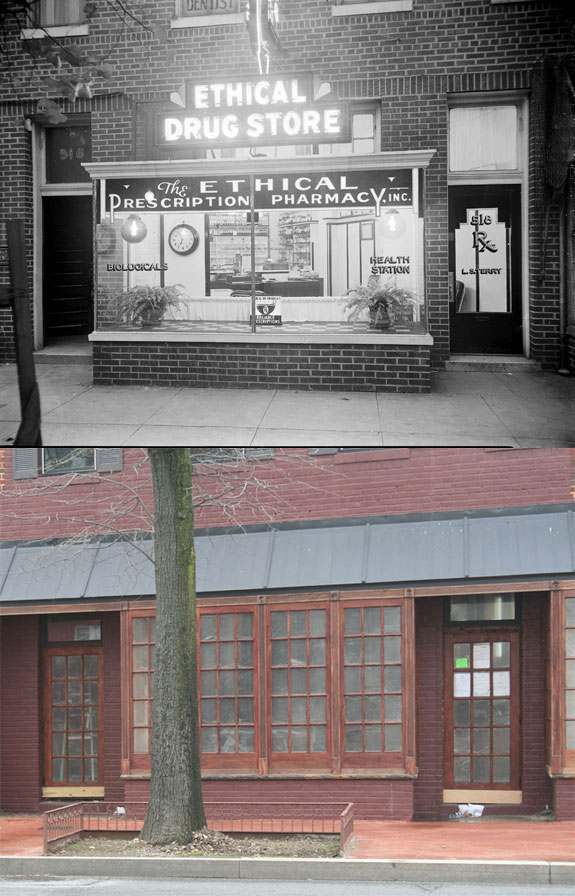
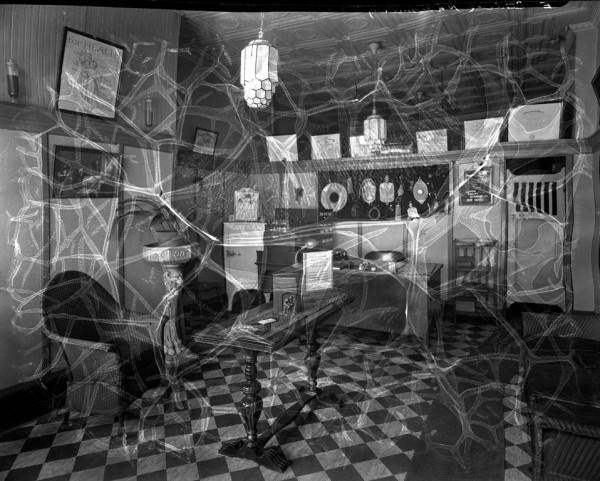

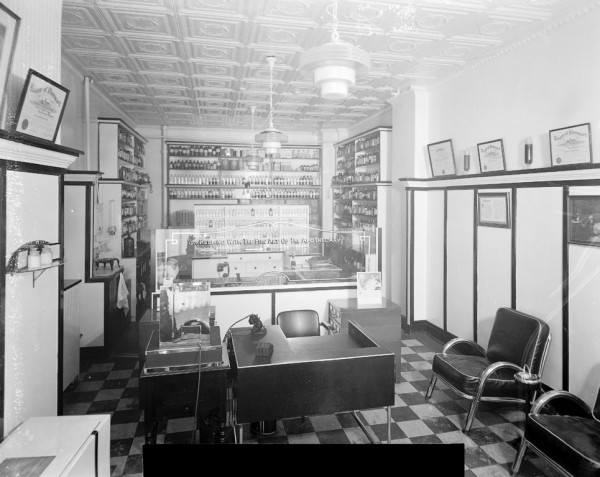

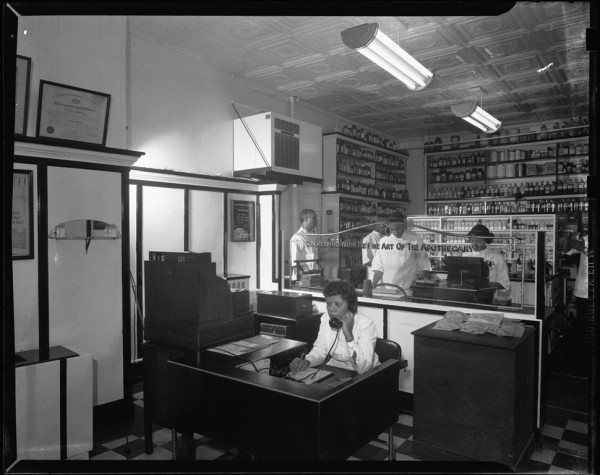
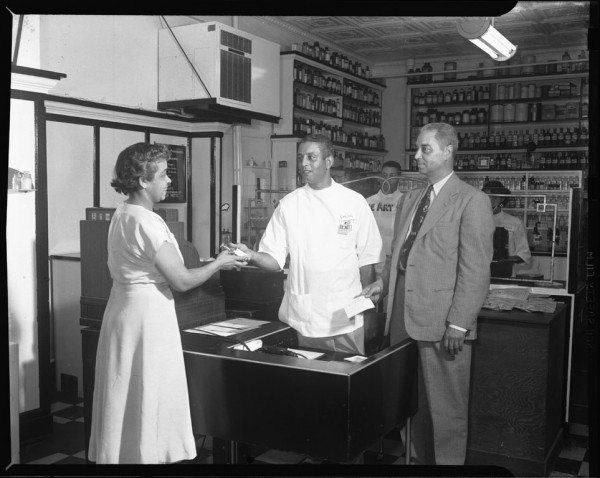







Recent Comments